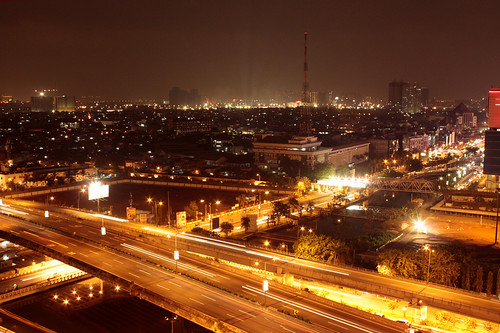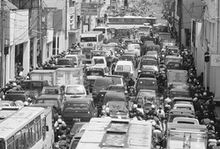New Elevated Roads will not Ease Jakarta's Traffic Woes
On February 6, 2012, Jakarta Globe reported the ongoing construction work of two elevated roads: 5.5 kilometers Antasari-Blok M and 2.3 kilometers Casablanca-Sudirman. The city officials said the works were set to be completed by August 2012 and expected to ease traffic density in the area by half. Will elevated roads eas Jakarta’s traffic woes?
The traffic congestion in Jakarta can't be separated from the high growth rate of vehicle ownership -- 236 cars and 891 motorcycles per day or about 10 percent per year -- which is not supported by the growth of road development, which is only less than 1 percent per year. The development of new roads will never meet the high growth rate of vehicle ownership. A new highway or a widened road only alleviates traffic congestion for a short period of time. After a few years, any new highway fills with traffic that would not have existed if the highway had not been built. Similarly, any widened road fills with more traffic in just a few months. Such a phenomenon is called induced demand. Because of induced demand, neither building new roads nor widening roads are viable long-term solutions to traffic congestion.
The new roads will also undermine the efforts of developing the mass transportation system in Jakarta. The main idea of developing the mass transportation system including busway, monorail, and the Mass Rapid Transit (MRT) projects in reducing the traffic congestion is to reduce the number of car riders and motorcyclists in the Jakarta’s streets. The car riders and motorcyclists are expected to use the mass transportation modes and reduce the burden of the Jakarta’s streets. The new roads will attract car riders back to the Jakarta’s streets.
Not only will the elevated roads cause the induced demand and worsen traffic congestion, but also could jeopardize the livability of neighborhoods along the elevated road. In many cities in other countries, such as Seoul, New Orleans, San Francisco and New York City, the elevated freeways caused the declining livability of neighborhoods along the elevated freeways. In many developed countries, we have seen the shift in urban planning from enhancing mobility toward promoting livability.
In order to alleviate transportation problems in Jakarta, the city administration should focus their efforts on the completion of the Mass Rapid Transit (MRT). Jakarta is the largest city in the world without a metro or MRT. Major cities in Southeast Asia which have fewer population than Jakarta have had their metro systems for years, including Manila (1984), Singapore (1987), Kuala Lumpur (1995) and Bangkok (2004). The MRT would become the most expensive public projects in Jakarta’s history, but it is the answer to ease the Jakarta’s traffic jams. The critical key for the Jakarta's success in overcoming the traffic congestion is the conversion of car riders and motorcyclists into public transport riders/MRT riders rather than the development of new elevated roads.
(This article also appeared at The Jakarta Globe on February 14, 2012)
The new roads will also undermine the efforts of developing the mass transportation system in Jakarta. The main idea of developing the mass transportation system including busway, monorail, and the Mass Rapid Transit (MRT) projects in reducing the traffic congestion is to reduce the number of car riders and motorcyclists in the Jakarta’s streets. The car riders and motorcyclists are expected to use the mass transportation modes and reduce the burden of the Jakarta’s streets. The new roads will attract car riders back to the Jakarta’s streets.
Not only will the elevated roads cause the induced demand and worsen traffic congestion, but also could jeopardize the livability of neighborhoods along the elevated road. In many cities in other countries, such as Seoul, New Orleans, San Francisco and New York City, the elevated freeways caused the declining livability of neighborhoods along the elevated freeways. In many developed countries, we have seen the shift in urban planning from enhancing mobility toward promoting livability.
You can read the story of the Chonggyecheon freeway in Seoul, the New York City’s West Side elevated highway, two elevated freeways in San Francisco-- Embarcadero and Central Freeways and the New Orleans elevated expressway in the previous post. Learning from those stories, it is clear that the elevated roads is not the solution for the traffic congestion in Jakarta, and also they could cause the decline of livability of neighborhoods along the elevated roads.
In order to alleviate transportation problems in Jakarta, the city administration should focus their efforts on the completion of the Mass Rapid Transit (MRT). Jakarta is the largest city in the world without a metro or MRT. Major cities in Southeast Asia which have fewer population than Jakarta have had their metro systems for years, including Manila (1984), Singapore (1987), Kuala Lumpur (1995) and Bangkok (2004). The MRT would become the most expensive public projects in Jakarta’s history, but it is the answer to ease the Jakarta’s traffic jams. The critical key for the Jakarta's success in overcoming the traffic congestion is the conversion of car riders and motorcyclists into public transport riders/MRT riders rather than the development of new elevated roads.
(This article also appeared at The Jakarta Globe on February 14, 2012)






5 comments:
Better to say "will not enough". Of course the Capital needs more infrastructure.
Better to say "will not enough". Of course the Capital needs more infrastructure.
Hi Deden, I really enjoyed your posts. Been looking for sites dedicated to urban-planning in Jakarta. A lot of the solutions to the problems in our country is a no-brainer. Unfortunately to implement them is difficult.
Anyway, since we are on the subject of traffic jams, can you check out my blog too? While we are not focused on the same topics, I just happened to cover something that might be of interests to you. I wonder if it would be possible for us to link up each other's blog, I'll be glad to.
http://nolanmarketeer.com/2012/03/30/protests-fueled-price-hikes-addiction/
Professor, I am glad to have found your blog. I will be traveling to Jakarta and Bandung in July as part of a U.S. Deptarment of State program called "Teachers for Global Classrooms". 11 secondary level U.S. teachers will be visiting Jakarta and then breaking up into teams and visiting other communities throughout Indonesia. Urban issues is the shaping up to be the key theme I wish to observe during my time, thus the importance of finding your blog. My travel blog can be found at www.roamingremoteroads.blogspot.com.
Thank you!
David
Please find more discussions on "Indonesia's urban studies" in the mailist: http://tech.groups.yahoo.com/group/urbanscholars/
Post a Comment